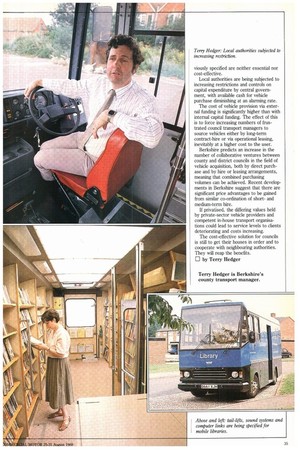UP WITH
Page 32

Page 33

If you've noticed an error in this article please click here to report it so we can fix it.
THE TIMES Cost-effectiveness and private-sector competition are challenges now being met by many councils' transport departments. The Royal County of Berkshire centralised its transport operation in 1979 and is learning how to cope with the ever-changing demands.
• The advent of the Local Government Act 1988 has already had some affect on local authority policies and practice with vehicle operations, but the most dramatic affects are yet to be experienced.
Traditionally, in-house council transport operations have fallen into one of two categories: the "every department goes its own way" approach, or the "central transport" system.
Although the Audit Commission report Improving Vehicle Fleet Management In Local Government, published in 1984, has acted as a stimulus to some councils to centralise their transport operations, others still seem to be trying to maintain their departments' independence. These councils are in danger of losing out to the private-sector when faced with statutory competition. There is precious little time left before the competition deadlines arrive to achieve the levels of efficiency which such competition demands.
FLEET MAINTENANCE
In 1979 the Royal County of Berkshire was probably one of the first local authorities to set up a central transport operation. The transport division trades as two units: Fleet Operations, which supplies vehicles on contract-hire to customers in other departments: and fleet maintenance, which supplies maintenance facilities to both Fleet Operations and many other organisations.
Originally, its approach to vehicle design and specification was: "This is the standard vehicle range—how can we meet customers' needs from it?"
In the background Berkshire was conscious of wanting to standardise by minimising the number of makes, models and types of vehicles used to give te users what it thought they wanted.
The effect of that policy was to minimise costs by maximising purchasing potential and maintenance efficiency — but it was achieved at the expense of providing the user with the most effective means of doing the job.
More recently attitudes and priorities have changed. While still keeping a wary eye on the commercial aspects, the first concern is to provide users with what they actually want. The council takes great care to discuss all of the problems which the transport engineers can foresee, but which professionals in other disciplines might not anticipate.
If, for example, the customer wants quadrophonic sound systems in a Mercedes-Benz (or an excavator) the pros and cons are discussed and, if still required, it will be supplied.
In recent times specifications have been very closely tailored to the users' identified current and projected needs, such as mobile library vehicles and welfare ambulances. Up-market coach-style construction has been the basis of mobile libraries for several years. Such vehicles often travel less than 10,000km (6,000 miles) a year but are expected to provide a high degree of reliability over a service life of 10 years, with a further two years in reserve. In these circumstances a goodquality, long-life body becomes a priority.
Tail-lifts, to give access to elderly or wheelchair-bound clients; the loaning of audio cassettes, which requires sound systems for on-board "sampling"; radio telephone and computer links are all examples of the increasing sophistication which clients specify, get and pay for.
The client's image is increasingly important and former policies of strong corporate identity are falling from favour.
Welfare ambulances (a rapidlyexpanding area in Berkshire) now need to be built to cope with increasing passenger loads and to comply with the code of practice produced by the Motor Industry Research Association and the Transport and Road Research Laboratory. It is also increasingly apparent that clients want low-profile vehicles, with little emphasis on corporate identity. This appears to be for reasons of social stigma.
BODYBUILDERS CODE
Since the launch of the Society of Motor Manufacturers and Traders, Commercial Vehicle Bodybuilders Code, Berkshire has had to have bodywork constructed to that standard. Compulsory competition may be invited by authorities on either the basis of maintenance, as set out in the Act, or on contract hire.
Such competition could well have the effect of reducing specifications and standards to the most cost-effective combination for the supplier — possibly to the detriment of the user. The reasons are: IE Comparisons of contract-hire costs may not reflect the specifications and standards formerly supplied in-house. E Clients may downgrade their specifications if subjected to external scrutiny. El If the in-house unit loses out in competition, then the engineering expertise will be lost to the client.
CI Many clients are operating services which are themselves being subjected to statutory competition and are suddenly realising that the expensive extras pre
viously specified are neither essential nor cost-effective.
Local authorities are being subjected to increasing restrictions and controls on capital expenditure by central government, with available cash for vehicle purchase diminishing at an alarming rate.
The cost of vehicle provision via external funding is significantly higher than with internal capital funding. The effect of this is to force increasing numbers of frustrated council transport managers to source vehicles either by long-term contract-hire or via operational leasing, inevitably at a higher cost to the user.
Berkshire predicts an increase in the number of collaborative ventures between county and district councils in the field of vehicle acquisition, both by direct purchase and by hire or leasing arrangements, meaning that combined purchasing volumes can be achieved. Recent developments in Berkshire suggest that there are significant price advantages to be gained from similar co-ordination of shortand medium-term hire.
If privatised, the differing values held by private-sector vehicle providers and competent in-house transport organisations could lead to service levels to clients deteriorating and costs increasing.
The cost-effective solution for councils is still to get their houses in order and to cooperate with neighbouring authorities. They will reap the benefits.
1=1 by Terry Hedger
























































